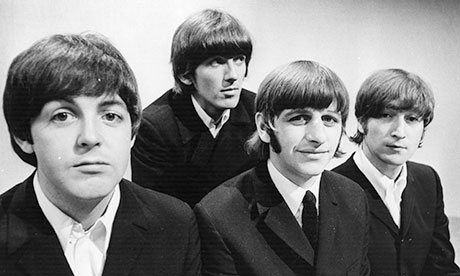 McMillian, John. Beatles vs. Stones, Simon and Schuster, New York 2014 (304pp. $26)
McMillian, John. Beatles vs. Stones, Simon and Schuster, New York 2014 (304pp. $26)
Before they were the Beatles they were four teenage “scousers” from Liverpool who seemed unlikely to be remembered by anyone. Save for Ringo who lived in bone-crushing poverty and possessed a genuinely sweet nature, the lads were profoundly working-class and also juvenile delinquents who dressed in black, slicked their hair, smoked cigarettes, and did petty crimes. Lennon was the only one who grew up in a home with indoor plumbing, and he was unequivocally a thug, pocketing change from the church collection box, pulling down girls’ underpants, bullying his way to the position of “King Pin” of an urchin gang— gambling, picking fights, setting fires and vandalizing phone booths. He could be spectacularly cruel, an abnormal cad around women, with a bad temper exacerbated by alcohol. His best childhood friend, Pete Shotton, thought him “bad news” headed for Skid Row.
The Stones by contrast, would have thought of “scousers” with derision, a natural attitude given England’s geographical prejudices and class pretense. To a man, the five were from southern England on the outskirts of London and two, Jagger and Richards, grew up in middling prosperity. Jagger’s well-educated father was a schoolmaster, and their three-bedroom home had a name: “Newlands”. They vacationed in Spain and St. Tropez. Even Richards, an eventual heroin addict and reverse snob, came from Dartford, and attended the same primary school as his mate, Jagger. Although working class, Charlie Watts worked as a graphic designer, while Charlie Wyman, considerably older than the other Stones, sold clothes in a department store and played bass semiprofessionally. Unlike those Liverpudlian scousers, the Stones could expect to be remembered for something.
Of course, they all will be remembered by everybody, forever. And John McMillian’s rich, engaging, and thoroughly researched new book is a grand story, maybe, except for the story of Louis Armstrong and jazz, the most important musical story of the twentieth century. McMillian is an assistant professor of history at Georgia State University. Beatles vs. Stones displays the sure professional touch of a serious historian. His use of obscure teen magazines, offbeat underground newspapers, and inside-the-band accounts, animates a “you are there”, Mailer-style knowledge. That, coupled with what can only be called a journalist’s sure nose for noise, makes Beatles vs. Stones that most precious thing—a prize potboiler with the poise and crescendo of first-rate cultural history.
Most of all, Beatles vs. Stones is the story of artistic creation which, when melded with skillful public relations and advertising, makes for mass popularity. It didn’t hurt that society was ready for them and had been softened up by the beatniks, rhythm and blues, and Elvis. It didn’t hurt that John and Paul were enormously, almost ridiculously, talented. It didn’t hurt that the scruffy Beatles played thousands of hours of live music in dank quayside bars in Hamburg, and wound by up by 1962 playing every night at the Cavern in Liverpool, building their craft—superior musicianship, two part harmony, two-part unison, then three part harmony, always, in the words of their engineer Geoff Emerick, in tune even on first takes and amid the screams of live audiences.
For the Stones, the way up came through live performance as well. They played grimy bars in Richmond, then got a job at a blues joint run by Georgio Gomelsky, a Soviet-born, Swiss educated, London transplant who promoted raw R and B, first in central London, then on the outskirts. Brian Jones, the first Stones front man, pleaded with Gomelsky to take them on. He did, and the Stones built a following, expanded their repertoire, and, encouraged by John and Paul, began to write for themselves.
In reality, there was no Beatles versus Stones, a fact McMillian makes clear. John and Paul helped and encouraged Mick and Keith. Mick and Keith were in the dugout at Shea in 1964, just after Ed Sullivan. The bands played together on the same bill at Albert Hall. Sometimes they had jealousies, ones natural to competing talents. But they were friends, and friendly, everybody rolling in money, girls and fame. McMillian’s book also brings to light a deep trove of music business lore and craft, recording techniques, management styles, and the evolution of rock fashion, showing how each band, and in some cases, each individual, evolved amid the cultural chaos. Amusingly, the Beatles—-rough, uneducated working class scousers, eventually emerged with a clean-cut image appealing to young girls; the Stones, solidly middle class and educated, cultivated a rough edged, even violent image, appealing mainly to young men.
No matter the image, together these two bands produced twelve or so of the most exciting albums of rock music ever made—Rubber Soul, Revolver, Sgt. Pepper’s….The Stones’ run of Beggars Banquet, Let It Bleed, Sticky Fingers and Exile on Main Street (1968-72), all this brilliant rock coming at us just when we were young and ready.

